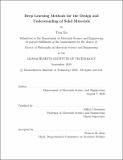| dc.contributor.advisor | Jeffrey Grossman. | en_US |
| dc.contributor.author | Xie, Tian,Ph.D.Massachusetts Institute of Technology. | en_US |
| dc.contributor.other | Massachusetts Institute of Technology. Department of Materials Science and Engineering. | en_US |
| dc.date.accessioned | 2021-01-05T23:15:40Z | |
| dc.date.available | 2021-01-05T23:15:40Z | |
| dc.date.copyright | 2020 | en_US |
| dc.date.issued | 2020 | en_US |
| dc.identifier.uri | https://hdl.handle.net/1721.1/129054 | |
| dc.description | Thesis: Ph. D., Massachusetts Institute of Technology, Department of Materials Science and Engineering, 2020 | en_US |
| dc.description | Cataloged from student-submitted PDF of thesis. | en_US |
| dc.description | Includes bibliographical references (pages 127-145). | en_US |
| dc.description.abstract | The trend of open material data and automation in the past decade offers a unique opportunity for data-driven design of novel materials for various applications as well as fundamental scientific understanding, but it also poses a challenge for conventional machine learning approaches based on structure features. In this thesis, I develop a class of deep learning methods that solve various types of learning problems for solid materials, and demonstrate its application to both accelerate material design and understand scientific knowledge. First, I present a neural network architecture to learn the representations of an arbitrary solid material, which encodes several fundamental symmetries for solid materials as inductive biases. Then, I extend the approach to explore four different learning problems: 1) supervised learning to predict material properties from structures; 2) visualization to understand structure-property relations; 3) unsupervised learning to understand atomic scale dynamics from time series trajectories; 4) active learning to explore an unknown material space. In each learning problem, I demonstrate the performance of the approach compared with previous approaches, and apply it to solve several realistic materials design problems and extract scientific insights from data. | en_US |
| dc.description.statementofresponsibility | by Tian Xie. | en_US |
| dc.format.extent | 145 pages | en_US |
| dc.language.iso | eng | en_US |
| dc.publisher | Massachusetts Institute of Technology | en_US |
| dc.rights | MIT theses may be protected by copyright. Please reuse MIT thesis content according to the MIT Libraries Permissions Policy, which is available through the URL provided. | en_US |
| dc.rights.uri | http://dspace.mit.edu/handle/1721.1/7582 | en_US |
| dc.subject | Materials Science and Engineering. | en_US |
| dc.title | Deep learning methods for the design and understanding of solid materials | en_US |
| dc.type | Thesis | en_US |
| dc.description.degree | Ph. D. | en_US |
| dc.contributor.department | Massachusetts Institute of Technology. Department of Materials Science and Engineering | en_US |
| dc.identifier.oclc | 1227037031 | en_US |
| dc.description.collection | Ph.D. Massachusetts Institute of Technology, Department of Materials Science and Engineering | en_US |
| dspace.imported | 2021-01-05T23:15:39Z | en_US |
| mit.thesis.degree | Doctoral | en_US |
| mit.thesis.department | MatSci | en_US |
